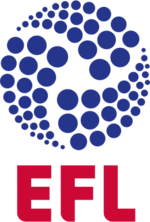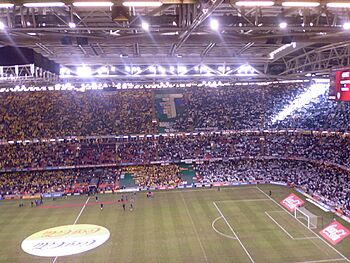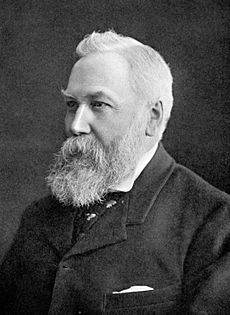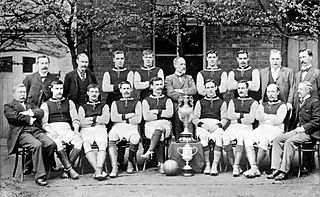English Football League facts for kids
 |
|
| Founded | 17 April 1888 |
|---|---|
| Country | England (68 teams) |
| Other club(s) from | Wales (4 teams) |
| Confederation | UEFA |
| Divisions | |
| Number of teams | 72 |
| Level on pyramid | 1 (until 1992) 2–4 (from 1992) |
| Promotion to | Premier League |
| Relegation to | National League |
| Domestic cup(s) | FA Cup |
| League cup(s) |
|
| Current champions | Leeds United (2024–25) |
| TV partners |
|
The English Football League (EFL) is a group of professional football clubs from England and Wales. It started in 1888 as the Football League. It is the oldest football league in the world! For a long time, it was the top football league in England. But in 1992, the best 22 clubs left to create the Premier League. The Football League changed its name to the "English Football League" (EFL) for the 2016–17 season.
The EFL has three main parts, called divisions: the Championship, League One, and League Two. Each division has 24 clubs, making 72 clubs in total. Teams can move up (get promoted) or down (get relegated) between these divisions. The top teams from the Championship can even swap places with the lowest teams in the Premier League. Also, the bottom teams in League Two can swap with top teams from the National League. Currently, four EFL clubs are from Wales: Cardiff City, Swansea City, Wrexham, and Newport County. The other 68 clubs are in England.
The EFL also runs two exciting cup competitions: the EFL Cup and the EFL Trophy. The main office for the Football League is in Preston, and its business office is in London.
Contents
How the EFL Competitions Work
The League Divisions
The EFL has 72 clubs, split into three divisions: the EFL Championship, EFL League One, and EFL League Two. Each division has 24 clubs. Every season, each club plays every other club in its division twice. This means they play one game at home and one game away, for a total of 46 games.
Teams get three points for winning a game, one point for a draw (a tie), and no points for losing. At the end of the season, clubs at the top of their division move up to the next higher division. Clubs at the bottom move down to the next lower division.
- Moving Up to the Premier League: Three clubs from the Championship get promoted to the Premier League. The three lowest-placed Premier League clubs then move down to the Championship.
- Moving Down from League Two: Two clubs from League Two move down to the National League. In return, two teams from the National League join League Two.
| Division | Teams Promoted Directly | Teams Promoted Through Playoffs | Teams Relegated |
|---|---|---|---|
| EFL Championship | Top two clubs | One club (from 3rd to 6th place) | Bottom three clubs |
| EFL League One | Top two clubs | One club (from 3rd to 6th place) | Bottom four clubs |
| EFL League Two | Top three clubs | One club (from 4th to 7th place) | Bottom two clubs |
To make things even more exciting, one promotion spot from each division is decided by a "playoff" tournament. This happens at the end of the season among four clubs. So, a team that finishes a bit lower in the standings can still get promoted if they win the playoffs!
Sometimes, clubs can lose points if they have money problems or use a player who wasn't properly registered. This helps keep the competition fair.
Cup Competitions
The EFL also runs two exciting knockout cup competitions: the EFL Cup (also known as the Carabao Cup) and the EFL Trophy (also known as the Vertu Trophy).
- The EFL Cup started in 1960. All EFL and Premier League clubs can play in it. The team that wins the EFL Cup gets a chance to play in a European competition called the UEFA Europa Conference League.
- The EFL Trophy started in 1983. It's for clubs in EFL League One and EFL League Two.
| Cup | Number of Clubs |
|---|---|
| EFL Cup | 92 |
| EFL Trophy | 64 |
History of the EFL
Football became professional in England in 1885. Before that, clubs often played games without a clear schedule. This made it hard for them to know how much money they would earn.
A man named William McGregor, who was a director at Aston Villa, wanted to make things more organized. In March 1888, he suggested creating a league where clubs would play a set number of games each season.
The Football League was officially created in Manchester on April 17, 1888. The first season began a few months later, on September 8, with twelve clubs from the Midlands and northern England. These clubs included Aston Villa, Blackburn Rovers, Preston North End, and West Bromwich Albion.
In the early days, teams got two points for a win and one for a draw. Preston North End won the very first league title without losing a single game! They also won the FA Cup that year, achieving a "double."
Adding More Divisions
In 1892, a new Second Division was created. This happened when another league, the Football Alliance, joined the Football League. This meant the League now had enough clubs for two divisions. The original division became the First Division, and the new one was the Second Division.
Over the years, more clubs joined, and the League grew. By 1950, there were 92 clubs in total.
The Premier League Forms (1992)
A big change happened in 1992. The top 22 clubs in the First Division decided to leave the Football League. They formed their own new league called the FA Premier League (now just the Premier League). They wanted to earn more money, especially from TV deals.
Even though the top clubs left, teams still move between the Premier League and the Football League. The Football League then reorganized its divisions. The old Second Division became the new First Division, the Third Division became the Second Division, and the Fourth Division became the Third Division.
Changes After 1992
After the Premier League was formed, it became harder for newly promoted teams to stay in the top league. Many would go straight back down. However, some teams, like Blackburn Rovers, did very well, even winning the Premier League a few years after it started.
The money difference between the Premier League and the Football League grew. This made it easier for teams relegated from the Premier League to bounce back quickly.
In 2004, the Football League changed the names of its divisions again. The First Division became the Championship, the Second Division became League One, and the Third Division became League Two.
EFL Rebranding (2016)
On November 12, 2015, the Football League announced it would officially change its name to the English Football League, or EFL. This change happened at the start of the 2016–17 season. The new logo has a circle made of 72 smaller circles, representing the 72 clubs in the league.
EFL Trophies
The English Football League has six different trophies. There's a special trophy for the Championship winner. The trophies for the League One and League Two champions, and for the playoff winners in all three divisions, have a similar design. All these trophies are made by British silversmiths called Thomas Lyte.
The champion's trophies are 50cm tall and have three handles, with the league champion's handles plated in gold. The playoff final trophies are 45cm tall. There are also smaller trophies for teams that finish as runners-up in each league.
Current Member Clubs
There have been 145 clubs that have been part of the Football League since 1888. Here are the clubs that are currently members of the English Football League.
Championship Clubs
- Birmingham City
- Blackburn Rovers
- Bristol City
- Charlton Athletic
- Coventry City
- Derby County
- Hull City
- Ipswich Town
- Leicester City
- Middlesbrough
- Millwall
- Norwich City
- Oxford United
- Portsmouth
- Preston North End
- Queens Park Rangers
- Sheffield United
- Sheffield Wednesday
- Southampton
- Stoke City
- Swansea City
- Watford
- West Bromwich Albion
- Wrexham
League One Clubs
- AFC Wimbledon
- Barnsley
- Blackpool
- Bolton Wanderers
- Bradford City
- Burton Albion
- Cardiff City
- Doncaster Rovers
- Exeter City
- Huddersfield Town
- Leyton Orient
- Lincoln City
- Luton Town
- Mansfield Town
- Northampton Town
- Peterborough United
- Plymouth Argyle
- Port Vale
- Reading
- Rotherham United
- Stevenage
- Stockport County
- Wigan Athletic
- Wycombe Wanderers
League Two Clubs
- Accrington Stanley
- Barnet
- Barrow
- Bristol Rovers
- Bromley
- Cambridge United
- Cheltenham Town
- Chesterfield
- Colchester United
- Crawley Town
- Crewe Alexandra
- Fleetwood Town
- Gillingham
- Grimsby Town
- Harrogate Town
- Milton Keynes Dons
- Newport County
- Notts County
- Oldham Athletic
- Salford City
- Shrewsbury Town
- Swindon Town
- Tranmere Rovers
- Walsall
Past League Winners
NB: Teams that won both the League and the FA Cup in the same season are highlighted in bold.
Early Years: One Division (1888–1892)
| No. | Season | Champions |
|---|---|---|
| 1 | 1888–89 | Preston North End |
| 2 | 1889–90 | Preston North End |
| 3 | 1890–91 | Everton |
| 4 | 1891–92 | Sunderland |
Two Divisions (1892–1920)
In 1892, the League added a Second Division. The original division became the First Division.
Three Divisions (1920–1921)
In 1920, a Third Division was added.
| No. | Season | First Division Champions | Second Division Champions | Third Division Champions |
|---|---|---|---|---|
| 29 | 1920–21 | Burnley | Birmingham | Crystal Palace |
Four Divisions (1921–1958)
In 1921, the Third Division split into North and South sections.
National Divisions (1958–1992)
From 1958, the Third and Fourth Divisions became national leagues, not split by region.
After Premier League Formed (1992–2004)
After the Premier League started, the Football League no longer had the top division. Its divisions were renamed.
| No. | Season | First Division Champions | Second Division Champions | Third Division Champions |
|---|---|---|---|---|
| 95 | 1992–93 | Newcastle United | Stoke City | Cardiff City |
| 96 | 1993–94 | Crystal Palace | Reading | Shrewsbury Town |
| 97 | 1994–95 | Middlesbrough | Birmingham City | Carlisle United |
| 98 | 1995–96 | Sunderland | Swindon Town | Preston North End |
| 99 | 1996–97 | Bolton Wanderers | Bury | Wigan Athletic |
| 100 | 1997–98 | Nottingham Forest | Watford | Notts County |
| 101 | 1998–99 | Sunderland | Fulham | Brentford |
| 102 | 1999–2000 | Charlton Athletic | Preston North End | Swansea City |
| 103 | 2000–01 | Fulham | Millwall | Brighton & Hove Albion |
| 104 | 2001–02 | Manchester City | Brighton & Hove Albion | Plymouth Argyle |
| 105 | 2002–03 | Portsmouth | Wigan Athletic | Rushden & Diamonds |
| 106 | 2003–04 | Norwich City | Plymouth Argyle | Doncaster Rovers |
EFL Divisions (2004–Present)
In 2004, the divisions were renamed to Championship, League One, and League Two.
Playoff Winners

The EFL playoffs are special games played at the end of the season. They decide the last team that gets promoted from each of the three divisions. This makes the end of the season very exciting for more clubs!
The playoffs started in 1987. At first, they involved teams from different divisions. But since 1989, the playoffs include the four teams that finished just below the automatic promotion spots in their own division. These four teams play in two semi-finals, and the winners then play in a final match. The team that wins the final gets promoted. The final is a single game, making it a thrilling event.
- 1: Because of money issues, Swindon could not take their place in the First Division. That spot was given to Sunderland, who lost the playoff final.
League Sponsors
The EFL has had different sponsors over the years, which means the league's name sometimes changed.
| Years | Sponsor | Name |
|---|---|---|
| 1983–1986 | Canon | Canon League |
| 1986–1987 | Today | Today League |
| 1987–1993 | Barclays | Barclays LeagueA |
| 1993–1996 | Endsleigh | Endsleigh League |
| 1996–2004 | Nationwide | Nationwide Football League |
| 2004–2010 | Coca-Cola | Coca-Cola Football League |
| 2010–2013 | npower | npower Football League |
| 2013–2016 | Sky Bet | Sky Bet Football League |
| 2016–2029 | Sky Bet EFL |
- A When the Premier League was formed in 1992, Barclays also became a sponsor for that new top division.
Watching the Games
Television deals are a big source of money for the EFL. In the 1980s, different TV channels competed to show League matches. When British Sky Broadcasting (Sky TV) arrived, they paid huge amounts of money for exclusive rights to show games.
After the Premier League was formed in 1992, the Football League lost its top clubs and the ability to get big TV deals. This caused some financial problems for clubs, especially when ITV Digital, a TV rights holder, went out of business in 2002.
However, the EFL has continued to sign new deals. For example, Sky Sports has broadcast many matches. Since the 2024–25 season, Sky Sports has been showing over 1,000 EFL matches each season. This includes games from the Championship, League One, League Two, all playoff matches, and all games from the EFL Cup and EFL Trophy.
You can also listen to many Football League matches on local radio stations.
Highlights Shows
| Highlights Programme | Years Broadcast | Broadcaster |
|---|---|---|
| Football League Extra | 1994–95 to 2003–04 | ITV |
| The Championship | 2004–05 to 2008–09 | |
| The Football League Show | 2009–10 to 2014–15 | BBC One |
| Football League Tonight | 2015–16 to 2017–18 | Channel 5 |
| EFL on Quest | 2018–19 to 2021–22 | Quest |
| English Football League Highlights | 2022–Present | ITV4 |
How the EFL is Run
The EFL is like a company, and its 72 member clubs are its owners. Most of its money comes from broadcasting games on TV.
The EFL Board
A group of ten directors leads the EFL. Six of these directors are chosen by the clubs from the different divisions. The other four include two independent directors, an independent chairperson, and the EFL's Chief Executive Officer. They help decide the overall direction for the league.
Current key members include:
- Rick Parry – Chairman
- Trevor Birch – Chief Executive
See also
 In Spanish: English Football League para niños
In Spanish: English Football League para niños




